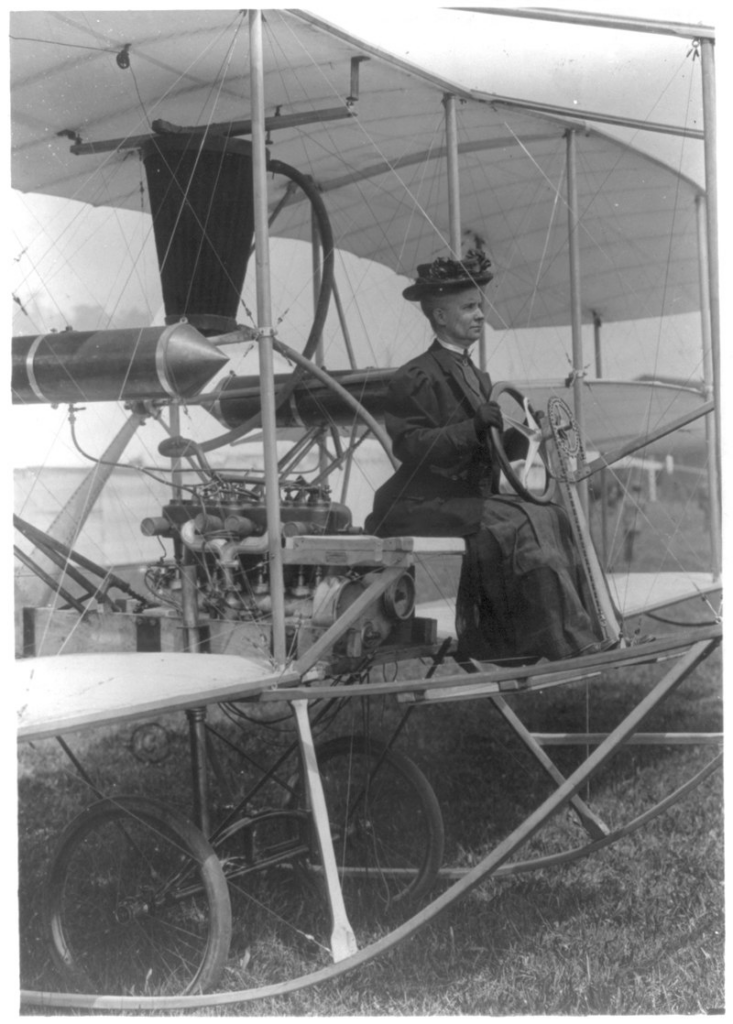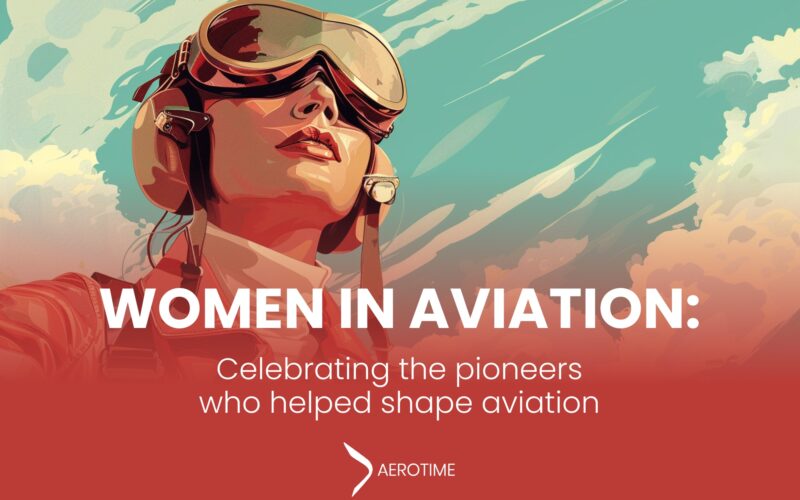Women have played essential roles in aerospace since the early days of airplanes, helicopters, and space travel. Though they began piloting powered aircraft as early as 1908, their conquest of the skies was limited not only by the laws of physics but also by the laws of men. For a long time, women were often confined to private or supportive roles within the aviation industry.
The situation remains bleak to this day. According to a 2021 study conducted by the International Society of Women Airline Pilots (ISA), women accounted for less than 6% of pilots globally. In the United States, the percentage of FAA-certified women airline pilots stood at just 4.9% in 2022.
In the continuous fight to achieve gender equality in the aerospace industry, it is important to reflect on the tremendous efforts by women throughout history in shaping a more equal future. To commemorate International Women’s Day, which is celebrated on March 8 each year, AeroTime has put together a selection highlighting some of the women who have made remarkable contributions to the aviation sector.
Emma Lilian Todd, the inventor who saw her right to fly denied

Emma Lilian Todd was already an accomplished inventor when she became interested in aviation. She presented her first model aircraft at Madison Square Garden in 1906. Olivia Sage, widow of politician Russell Sage, was impressed by her work and decided to fund the design of her first real plane. Todd began her aviation career in 1908, when she opened America’s first Junior Aero Club to support the training of future female aviators. She applied for a pilot’s license to test her biplane, but the request was refused. Her aircraft was flown successfully by Didier Masson on November 7, 1910. Following the flight, she abandoned aeronautical designs.
Thérèse Peltier, the first female passenger and pilot
Thanks to her friend, the aviation pioneer Léon Delagrange, Peltier became interested in aviation. However, there were no flying schools at the time. Instead, Peltier had to watch other pilots to learn how to fly a plane. She received a few lessons from Delagrange, during which she became the first woman passenger on a plane. In September 1908, she took off solo, becoming the first woman pilot.
The Wright sister, Katharine
If the Wright Brothers, Wilbur and Orville, are such famous pioneers, they owe part of their success to their sister, Katharine. After graduating from college, the young woman joined her two brothers in Europe as their spokesperson, while they were presenting their invention in various salons. She was qualified by the local newspapers as the “human side of the Wrights.” Wilbur himself said, “If ever the world thinks of us in connection with aviation, it must remember our sister.”
Raymonde de Laroche, the first woman to receive a pilot’s license

Elise Raymonde Deroche started her professional life as a drama actress in Paris. However, after meeting several aviators she soon developed a keen interest in aviation. In 1908, she witnessed one of the Wright brothers’ flights in Paris and she set her sights on flying. She applied to the aviation school of Charles Voisin, where she became the first woman in the world to receive her pilot’s license on March 8, 1910. From then on, she toured aviation meetings in Europe and beyond and broke several women’s altitude records.
Hilda Hewlett, pilot and entrepreneur pioneer
Hilda Hewlett was not even a licensed pilot when she opened the first flying school in the United Kingdom, along with aviation engineer Gustav Blondeau. In 1911, Hilda Hewlett became the first woman in the UK to earn a pilot’s license and went on to teach her own son how to fly. Still partnered with Gustav, she became the first woman to co-found an aircraft factory, Hewlett & Blondeau, that built Farman, Caudron, and Hanriot aircraft under license.
Bessie Coleman, the first woman of color to become a pilot
After hearing the stories of French and American aviators during the First World War from her two soldier brothers, Coleman became passionate about aviation and decided to learn how to fly. However, the United States was marked by racial segregation, and no flight school agreed to teach her how to pilot. Therefore, she moved to France and, after seven months of training, became the first person of African American and Native American descent to hold a pilot’s license, which she obtained on June 15, 1921. Her dream was to establish her flight school to teach African Americans how to fly, but she tragically died in a plane crash before she could achieve it.
Amelia Earhart, a life of records

In 1922, at the age of 25, Amelia Earhart broke her first record by reaching 4,300 meters (14,000 feet) on her bright yellow Kinner Airstar biplane named the Canary. Over the course of her career, Earhart would go on to break a dozen records. In 1928, she became the first woman to fly across the Atlantic, albeit as a passenger. Four years later, she flew solo from Newfoundland to Paris aboard a Lockheed Vega, becoming the first woman to do so, and the second pilot after Charles Lindberg to cross the Atlantic alone. In 1937, Amelia embarked on an even more ambitious adventure, attempting to become the first woman to fly around the world. Unfortunately, her twin-engine Lockheed Electra 10-E disappeared on July 2, 1937, as Amelia and her navigator Fred Noonan were trying to reach the tiny Howland Island, situated in the middle of the Pacific Ocean. To this day, the disappearance remains a mystery.
Sabiha Gökçen, the first female fighter pilot
The first President of the Republic of Turkey, Mustafa Kemal Atatürk, prioritized the development of military and civil aviation as part of his efforts to modernize the country. During the opening ceremony of the Türk Kuşu (Turkish Bird) civil aviation school in 1935, his adoptive daughter Sabiha Gökçen was deeply impressed by the flight and parachute demonstrations. At her father’s suggestion, she enrolled in the school, and later expressed interest in becoming a fighter pilot as she completed her training in the Soviet Union. It is unclear whether this was her own decision or an attempt by her father to showcase the modernity of the young nation. Sabiha then enrolled in the Turkish Air Force Academy, where she received combat training on the Breguet 19 light bomber and the Curtiss F11C Goshawk fighter, eventually becoming the world’s first female fighter pilot.
Jacqueline versus Jacqueline, a supersonic duel
In the early 1950s, two female pilots, Jacqueline Cochran from America and Jacqueline Auriol from France, were competing to be the fastest in the world. They kept breaking record after record, until it was ultimately Jacqueline Cochran who became the first woman to break the sound barrier on May 18, 1953. Chuck Yeager, the first man to break the sound barrier, assisted her on her mission. She did so on board her North American F-86 Saber. Jacqueline Auriol achieved the same feat three months later, using a Dassault Mystère II aircraft, which made her the first European woman to break the sound barrier.
Further than the clouds, Valentina Tereshkova
In 1962, Valentina Tereshkova, a 25-year-old textile factory worker, was selected for the Soviet Space program. Despite only having 90 jumps in a club of amateur parachutists, she underwent seven months of intense training and was eventually picked among five other women, most likely due to her humble beginnings. The entire selection process was kept in the utmost secrecy, even from her family, until the mission was eventually announced by the Soviet regime to the world two years after Yuri Gagarin’s historic flight. Onboard the Vostok-6 spacecraft, Tereshkova orbited the Earth 48 times during a three-day mission, alongside Valeri Bykovsky in Vostok-5. On June 16, 1963, she became the first woman to have flown in space and remains the youngest woman to have done so to this day.
Turi Widerøe, the first woman to become a commercial airline pilot
In 1968, Turi Widerøe made a significant contribution to the history of aviation by becoming the first woman to be hired as a commercial airline pilot by a major carrier. Her achievement was even more remarkable given the male-dominated nature of the industry at that time. Widerøe earned her private pilot’s license in 1962 and her commercial license in 1965. In 1968, she joined SAS and enrolled in the company’s flight academy. She eventually became certified to be a co-pilot on the Convair 440 Metropolitan.


1 comment
Amy Johnson CBE (1903-1941) was one of the most influential and inspirational women of the twentieth century. She was the first woman to fly solo from England to Australia in 1930 and set a string of other records throughout her career.